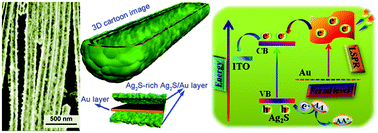Engineering one-dimensional trough-like Au–Ag2S nano-hybrids for plasmon-enhanced photoelectrodetection of human α-thrombin†
Abstract
One-dimensional (1D) morphology-unique Au–Ag2S nano-hybrids are achieved by combining the interfacial self-assembly of Ag nanowires, interface-oriented site-specific etching of Ag nanowires with AuCl4−, and the sulfurization of S2−. The as-formed Au–Ag2S nano-hybrid has a trough-like morphology. The wall of the Au–Ag2S nanotrough is a Ag2S/Au/Ag2S trilayer wall, but the Ag2S layer is a Ag2S-rich mixture of Ag2S and Au rather than pure Ag2S because of the diffusion of Au atoms towards Ag2S. The Au–Ag2S nanotrough shows strong absorption in the visible region (400–800 nm) and exhibits a favorable photoelectrochemical (PEC) response, the photocurrent of which is ∼8.5 times larger than that of pure Ag2S. This enhanced PEC response originates from the localized plasmonic resonance effect of Au. Moreover, the PEC biosensor based on the Au–Ag2S nanotroughs shows high sensitivity and selectivity, satisfactory reproducibility, and good stability towards human α-thrombin (TB) detection: a sensitive linear response ranging from 1.00 to 10.00 pmol L−1 and a low detection limit of 0.67 pmol L−1. This study provides a new model for studying the PEC behavior of plasmonic metal/semiconductor materials, and this Au–Ag2S nanotrough may also be useful in the fields of photocatalysis and photovoltaics.

- This article is part of the themed collection: Journal of Materials Chemistry B Lunar New Year collection 2021


 Please wait while we load your content...
Please wait while we load your content...